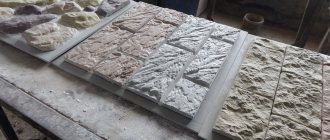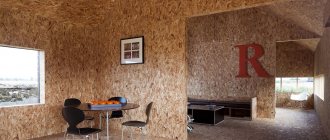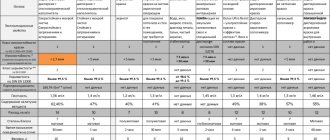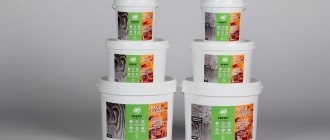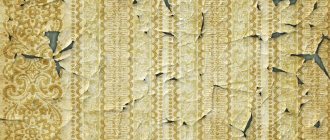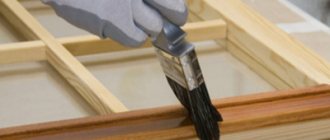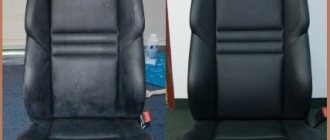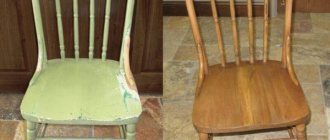Chalkboard paint is an excellent option for creating a stylish, modern interior. Elements with such a coating will be appropriate almost everywhere – from a children’s room to a solid office. Recently they have become a real design trend!
But the use of unusual paint in the interior is justified not only from a design point of view. Slate surfaces are also very practical. They are a great help in raising children, communicating with family, at work, and just in everyday life.
Features of slate paints
These paints are popularly called chalk paints. They create a durable matte, slightly rough coating on the surface on which you can write with chalk. The effect is like the familiar school board, only much better.
Modern slate paints have high performance characteristics:
- create a very hard, abrasion-resistant coating;
- have high adhesion;
- They don’t give any shine at all (drawing on such a surface is a pleasure);
- after drying - fireproof and non-toxic, suitable for use in children's rooms;
- easy to clean with soapy water (removing annoying chalk patterns is not a problem at all);
- Easy to apply and dries quickly.
On a note! Chalkboard paints are sold in cans (for application with a brush or roller) and in cans (for easy painting of geometrically complex surfaces).
Manufacturers offer ready-made emulsions in a variety of colors. Thus, Siberia paint is available in gray, burgundy, brown, black and dark green. Tikkurila offers those who wish to tint the colorless base into one of the three hundred shades of the branded palette. And Rust-Oleum has a completely transparent slate coating. It can be applied to any colored surface in the house.
Have you noticed how significant a role different colors play in our lives?
Scientists have long drawn attention to the direct relationship between a person’s mood and the color scheme of the interior in which he spends most of his time. For most people, color matters a lot. Color therapy is an ancient science. It appeared in the IV-III millennium BC. The founders of this science were China and India.
She proves that different colors give us different sensations.
Yellow color is warm and light. It looks like a sunny day, so it lifts the mood, a person experiences joy and fun.
Purple and blue are from a dark and cold palette. They cause indecision and a gloomy mood.
Light blue color evokes in people a feeling of flying in the sky and the lightness of the air. But walls painted dark blue can completely “freeze” you and cause students in such a room to feel sad and cold.
Light green colors in the classroom give a feeling of calm and warmth of summer, and a dark green shade, close to swamp on the contrary, seems soft and heavy.
Warm green shades are the colors of the foliage. This color calms and relaxes people, making them want to sleep and dream.
Shades of brown appear hard and earthy to people, while pure orange appears soft and warm.
A rich red hue first of all causes aggression and anxiety, and then is associated with strength and activity.
Warm, vibrant colors - shades of yellow and red - always outweigh calm ones - cold blue and green, so in small rooms it is better to use them in minimal quantities. These bright active colors always sink deeper into memory, so it will be very successful to use red or yellow in order to highlight something, draw attention to something, or put an accent. Blue and green colors are not suitable for this.
In a classroom, it would be a good idea to combine green and yellow colors. If the wall on which the board is located and where the students’ eyes are directed is painted green, and the side walls are yellow, then the students’ eyes will be less tired during class. And, at the same time, the yellow tint will fill the room with light and warmth.
Studies of the influence of indoor colors on the psyche of children have shown that children of different ages prefer different color schemes.
In elementary school, students choose active, bright colors, such as shades of red and pink. Moreover, the latter is predominantly chosen by girls.
By the end of primary school, color preferences change and by the age of 9, red and pink shades are replaced by orange, later children choose yellow and yellow-green colors, and by the age of 11, green with its shades prevails.
A year later, children prefer blue and its variants. Thus, it turns out that younger schoolchildren are not at all annoyed by the color red, but even vice versa. For an overly active child, the details of red flowers in the interior of the classroom will calm and organize. Therefore, any red details in the children’s classroom will help organize, calm and set them in a working mood.
A very unfortunate color in the interior is black, so you should not use a black board in the classroom; it is better to choose a dark green or dark blue surface for writing. The wall on which the chalkboard hangs should be in harmony with the color of the chalkboard; contrasting shades should not be chosen. Too many colors on the main wall of the classroom will bore children.
When decorating an office for teenage children, pay more attention to the color blue, because it is what teenagers choose. But do not forget that blue itself creates a sad and cold atmosphere, so it is best to combine it with warm orange. Shades of orange or yellow will help children focus their attention during activities.
Labor and music rooms are best decorated in blue tones. And the gym for physical education should be painted in a combination of light blue and light green.
The most unsuccessful colors in school decoration will be dirty, grayish tones. They may be considered suitable for clothing, but they cannot be used in interiors. Choose only pure colors and shades.
Halls, staircases, corridors and halls of the school should be spacious and warm. It is better to paint them in colors that differ from the colors of the classrooms, because children should take a break from classes in them. Combinations of light blue and yellow and other contrasting options are suitable.
Bright, warm, pleasant and varied colors in school interior design will brighten up everyday school life and make children's learning more enjoyable, fun and easier.
From us you can buy ready-made stands and we can also make mock-ups for free according to your individual requirements:
Catalog of school stands
What to paint under the slate
Chalkboard paints can be used throughout the home:
- In the nursery. If you install a large board here or paint over an entire wall with chalkboard, children will have a place to create and learn. And the rest of the walls in the house will be completely safe.
- In the kitchen. Individual slate boards, kitchen aprons, and painted kitchen cabinet doors look very nice here. You can write down recipes, menus, reminders, shopping lists, and just declarations of love for each other on them.
Important! Some paints become discolored by hot grease, so they should not be applied near a stove.
A variety of materials can be painted to look like lead:
- wood, chipboard, MDF, fiberboard;
- metal;
- plaster;
- drywall;
- brick;
- glass;
- ceramics.
Dyeing technology
Chalkboard paint is very easy to use. Anyone can paint a wall or make a cute note board with their own hands.
The painting procedure is as follows:
- The surface to be painted should be cleaned of old coatings. If necessary, it is leveled with putty or sanded, and then washed to remove dust and dried.
- To ensure that the paint lies evenly, the surface underneath is primed and dried. Ideally, you should use a special primer for slate paints.
- To create a neat slate rectangle on the wall or refrigerator door, cover the surface around the perimeter with masking tape.
- The emulsion is mixed well and applied in several layers. Each layer must be completely dry before the next one is applied. Painting should be done in a ventilated area with an air temperature of +10°C and humidity up to 85%.
Advice! Slate paints harden quickly, so you need to work with them quickly.
You can wash the slate surface with soap or other household chemicals only a month after painting.
How to make your own slate paint
Factory emulsion is sold in cans and jars of 0.5 and 1 liter. But many simply do not need such an amount of material. In this case, paint with a chalkboard effect can be made with your own hands. It's much cheaper.
First way
All you need is:
- Any acrylic paint – 1 cup.
- Cement (regular “pure” or any cement mixture) – 2 tablespoons.
The ingredients are thoroughly mixed and inexpensive chalkboard paint is ready.
On a note! Dolomite or marble chips are added to factory paint. A homemade cement mixture will not provide such a durable coating. It will get scratched faster.
The most difficult and interesting thing in this matter is choosing the color of the emulsion. Many people don't like traditional dark shades. In this case, you can use other colors on which the chalk pattern will be visible. Light, faded, pastel colors are immediately excluded. But it will be almost as convenient to draw on a bright background as on a dark one. Excellent options are bright red, rich purple, grass green, deep blue.
Compositions with interesting effects
Specialized compositions will greatly simplify the process of creating a chalk board
Advice! Chalk boards are not only used in school. At home, you can create a convenient place for notes, shopping lists and more, anywhere, even on your furniture.
And one more important note: people often ask the question online: is it possible to paint raw boards? There is only one answer: if you need a durable coating, then starting work before the material has dried is strictly prohibited.
What is the best paint for a school board?
It is advisable to choose a product specially designed for this purpose. The best paint for school boards, in our opinion and the information of many of our clients, is TIKKURILA LIITU chalkboard paint. This painting substance is matte, has anti-reflective properties, and does not shine. Those sitting in the center and in the side rows will equally well perceive the written information.
Special paints have many advantages. The main one is the composition. It contains special components that prevent the chalk from slipping and falling off. In addition, there will be no unpleasant, annoying sound in the classroom.
TIKKURILA LIITU chalkboard paint dries quickly. When children enter the classroom after the weekend, they will not smell the renovation. Chalkboard dyes are mostly water-based, so you won't need any solvents.
How to paint a blackboard
Take TIKKURILA paint and follow the instructions. The technique for using this product is no different from the method of using other paints. Need to:
Bring the surface into proper shape
Get rid of swollen and flaky layers of the previous coating. Sand the surface of the board and wipe off the dust. If necessary, putty and prime uneven areas.
Prepare paint for use
To do this, mix it and, if necessary, dilute with water.
Apply the substance
Use a short-haired brush or roller at your discretion. A minimum of 6 hours must pass before applying the next ball. To form an ideal coating, 1-2 layers of paint are enough.
Main destructive factors
That part of the terrace that is located in the open air is constantly exposed to the following negative influences:
- Precipitation (including acid rain).
- Temperature changes.
- Solar radiation.
- Microorganisms and mold that cause rotting.
- Insects.
Applying paints and varnishes to the surface of the decking board is one of the most effective ways to protect against all these phenomena.
In conclusion
The price of a TIKKURILA product is affected by the container volume. The cost of painting a school board will depend on the number of layers applied and the cost of tools (roller, brush, etc.). Remember, the school board perfectly fulfills its purpose if all the requirements for its coating are met. Select high-quality materials for work, follow the instructions - and the board will be great!
Chalkboard paint is considered an easy and affordable way to create a surface with a blackboard effect. On such unusual walls you can draw, erase and draw again. The dark gray surface itself looks original, and you can make thematic notes and sketches with multi-colored chalk. The option is also suitable for children's leisure.
What is Sanpin at school?
SaNPiN AT SCHOOL
(
sanitary rules and regulations
- “Sanitary and epidemiological requirements for the conditions and organization of training in educational institutions”) - a regulatory document of the Federal Service for Supervision of Consumer Rights Protection and Human Welfare (Rospotrebnadzor), regulating the requirements for ...
Interesting materials:
How to unlink a Google account from a website? How to unlink a Hikvision camera from your account? How to unlink Meiza from your Fly account? How to unlink mi band 3 from your account? How to unlink Samsung from Google account? How to unlink Samsung from your account? How to unlink a Smartwatch from your account? How to unlink Xiaomi Mi Band 3 from your account? How to unlink from Google account? How to transfer a Google account?
About slate paint
Can be used for walls in the kitchen, dining room, nursery or any other room. The finished coating is slightly rough and matte. You can make drawings, notes, sketches on it, and then simply wipe it with a rag. The main purpose of the paint and varnish material is the effective restoration of school boards.
In addition to its decorative function, the finished slate surface can be used for teaching and entertaining children. Painting can be applied both to bare walls and to wallpaper (which can be painted).
To ensure a magnetic effect, after drying, a special primer is applied to the wall.
Properties that paint should have
Paint for decking boards must have the following properties:
- Frost resistance. Paints and varnishes must withstand extreme temperature changes, including extreme cold.
- Moisture resistance . This term refers to the ability of paint to reject moisture from its surface after it dries. If the paint does not have hydrophobic properties, then even the slightest precipitation will lead to moisture penetration into the pores of the wood and its deformation. Moisture resistance can be enhanced by special impregnation for the terrace.
- Resistance to burnout. We are not talking about exposure to open fire, but about staying under prolonged solar radiation. Poor quality paint fades in the sun, that is, it loses its color and properties.
Important! When purchasing paint for a terrace, it is necessary to take into account the fact that for terrace paint all the properties that are listed must be significantly higher than for paint for treating the interior surfaces of a room. Since the terrace experiences much stronger environmental influences.
Peculiarities
The main component of the product is latex, which can be diluted with water and without being exposed to harmful toxins and solvents. The ability to draw and attach magnets to the coating is explained by the fact that the chalkboard product contains tiny iron particles. The addition of gypsum, cement, acrylic resins, and marble chips determines the dullness and strength of the finished coating. Additionally, it contains dolomite, modifiers that increase the strength of the coating.
Walls can be painted in grey, black, red, blue, green or brown. For greater brightness, the mixture is tinted. If in a student’s room such a surface will help solve mathematical problems, then in the kitchen there will be a place to write down a recipe or add to the shopping list. The composition is completely natural and safe. It can be applied in residential indoor spaces.
After drying, the result is a very hard coating that is resistant to abrasion and has increased adhesion. The finished surface is non-toxic and fireproof. You can remove dust and clean dirty areas with a soft cloth soaked in a soap solution. A sponge is suitable for erasing chalk.
Features of decking boards
Decking boards are produced by pressure molding a mixture of wood and synthetic sawdust, and to add color, a coloring pigment is additionally added to the mixture. This board is also called wood-polymer composite (WPC). Laying a terrace has a special term - decking.
Important! Mainly larch is used as wood.
The table shows the main technical features of decking boards:
| Technical Parameter | Meaning |
| Density | 1.2 g/cm2 |
| Moisture absorption | 5% |
| Surface wear | 0.1 g/cm2 |
| Temperature range | From 0 45 to + 70 °C. |
| Fire safety | Class – G4 (ignites on an open fire) |
Positive characteristics:
- Hydrophobicity. High moisture resistance ability.
- Does not attract insects and rodents due to synthetic components in the composition.
- In order for the decking board to catch fire, prolonged exposure to a temperature of at least 600 °C is required.
- The material is completely environmentally friendly.
- Does not react to cleaning agents.
- Doesn't slip when walking.
- Service life is not less than 50 years.
- It is easy to paint.
Flaws
- A defective board may be subject to deformation and be out of sync with the uniform geometry of the rest of the surface.
- Externally it may resemble plastic panels.
- Some manufacturers produce boards with a polymer smell.
What can be painted
Chalkboard paints are suitable for application:
- on plaster;
- wooden covering (for example, chipboard or fiberboard);
- metal surfaces;
- wallpaper for painting;
- glass wallpaper;
- drywall;
- ceramic planes;
- glass.
The only requirement concerns compliance with the temperature regime. Suitable exclusively for interior work. For maximum durability and strength of the coating, it must be applied in several layers. Especially if the coating will be used as a magnetic board.
Types of paints
The paint itself is sold in cans and in spray form. For application you need a roller or brush. Using cylinders, hard-to-reach places, small objects, and individual interior parts are painted. The slate mixture is also classified according to its composition and properties, for example:
- classic or graphite (you can write with chalk);
- marker (for drawing with markers when there is no desire to regularly remove chalk dust in the room);
- magnetic paint for walls (allows you to attach drawings, photographs, small parts using magnets).
Marker paints cost significantly more. They dry in about 4-5 days, and the durability guarantee is about 10 years. Paint consumption is 1 liter per 6 m2.
What should the working surface of a study desk be?
According to SanPiN 2.4.2.2821-10, the main type of furniture for students of primary general education should be a school desk equipped with a tilt regulator. When learning to write and read, the inclination of the working surface of the school desk should be 7-15 degrees.
Interesting materials:
The ground at the dacha is covered with moss, what should I do? The soil in the greenhouse has turned green, what should I do? Iron lightning diverges, what should I do? Garlic turns yellow in spring, what should I do? Tomato seedlings turn yellow, what should I do? The thuja is turning yellow, what should I do? Winter garlic turns yellow, what should I do? The edges of cucumber leaves turn yellow, what should I do? The leaves on the tomatoes are turning yellow, what should I do? Garlic leaves turn yellow, what should I do?
Advantages
Chalkboard effect paint has operational advantages:
- resulting in a hard, durable coating that can withstand even mechanical wear;
- environmental safety of the composition;
- absence of characteristic, pungent odors;
- ability to choose shades;
- increased coating adhesion;
- fire resistance, explosion safety;
- ease of washing off drawings and inscriptions with soapy water;
- antiseptic effect.
The functionality of coatings is difficult to overestimate. In addition to walls, this product can be used to cover kitchen aprons, doors, and individual interior items.
Flaws
When painting walls or any other surfaces in a room, it is important to take into account a possible allergic reaction to chalk dust (it is better to choose marker ones). The paintwork itself is only suitable for interior work, as it can deteriorate at sub-zero temperatures.
The surface itself must be washed thoroughly and regularly to prevent sloppiness. The surfaces to be treated must be perfectly flat. If you plan to coat aluminum or glass surfaces, they must first be carefully primed for greater adhesion.
How to paint correctly
An important requirement in the work concerns the complete leveling of the surface being treated; it must be cleaned of dust and grease. During the painting process, a standard painting kit will be useful, consisting of a brush, roller and container for the paint itself.
Preparation
Preparation for work consists of protectively covering the floor, for example, with thick cellophane. This will prevent hard-to-remove paint stains from getting onto parquet, laminate or linoleum. If walls near windows and doorways will be covered, then it is better to cover the surfaces themselves with paper tape. If paint is applied to wallpaper, the canvas must be smooth and pre-coated with a primer mixture.
Painting process
According to the instructions, you must first mix the paint thoroughly and then pour a small amount into a separate container. To apply the product to the surface, you need a brush or roller (depending on the amount of work). The coating should be carried out as evenly as possible.
Each subsequent layer can be applied no earlier than after 2-3 hours. The first drawings and writings on the surface can be left no earlier than 3 days after the last layer of paint has dried. For the first month, the coating can only be washed with clean water, without adding aggressive chemicals.
For a magnetic effect, an additional primer with small iron particles is applied to the paint.
Main types of protective compounds and features of their application
As noted above, it is important to choose the right option for a particular surface, but the process of preparing the base is no less important; in addition to a certain range of work, it is also necessary to use special compounds, which we will dwell on in more detail.
Types of wood impregnations
Let us note right away that some types of products discussed in this chapter can be used both as preparation and as a full-fledged independent coating.
So, how to treat boards before painting:
- Oils for impregnation are made on the basis of natural materials . The most commonly used oil is linseed oil, which penetrates well into the wood and gives it a semi-matte structure. This method of protection makes the surface much more resistant to adverse influences and serves as a good basis for applying natural-based paints and varnishes.
Linseed oil is a proven method for processing wooden products
- Antiseptic solutions are liquids with fungicidal additives that prevent the development of fungus in the material and damage to wood by woodworms . A very useful composition for treating external surfaces, as its use significantly extends the life of the wood. To ensure the best penetrating properties, the consistency of such products is very liquid.
Hard-to-wash-out compounds are the most reliable
- Fire retardant compounds are required for treating roofing systems and other structures . This event provides high resistance to fire - structures can withstand even an open flame and withstand its impact without loss of properties for at least 15 minutes. To simplify the process, we can recommend the use of a combined option - a fire-bioprotective composition.
A good option that allows you to solve two issues at once
- Acrylic primers are intended for preliminary preparation of the surface and its protection from adverse effects - dampness, ultraviolet radiation . Depending on the method of further processing, the composition can be white (painted), colorless (varnished) or with various shades that give the surface a resemblance to valuable wood species.
Primers allow you to strengthen the surface and create an additional protective layer
Advice! If it is necessary to apply a coating to external surfaces, even for the preparatory layer it is necessary to use weather-resistant compounds; temperature changes negatively affect products intended for interior decoration.
Compositions intended for final finishing
The most commonly used groups of compounds are:
- Oil and alkyd paints are used if the price of the material is important. This option is quite reliable, but there are other, more durable coatings. However, when painting surfaces previously finished with oil paint with your own hands, it is easier to use the same composition than to completely remove the remnants of the old layer, or even several.
- Acrylic-based water-based paints appeared relatively recently, but have already gained wide popularity. The compositions of this group are characterized by good adhesion to wooden substrates and high resistance to atmospheric influences. In addition, you do not need preparation instructions - the product is completely ready for use and, if necessary, it can be diluted with warm, clean water, and dirt can also be washed off with water.
Acrylic-based compositions - a universal solution for external and internal work
- If you need paint for decking, then polyurethane-based compositions are suitable. This group of compounds is distinguished by the highest properties of wear resistance and abrasion resistance - floor surfaces treated in this way will last a very long time. As you know, terrace panels themselves are very durable, but polyurethane paint can extend their service life for several more decades.
It is important to choose high quality products
- Various varnishes are used to create a transparent coating that emphasizes the structure of the wood. When choosing, pay special attention to the purpose of the composition - it can be for interior finishing work, for exterior finishing, or for working on furniture. Only the use of the optimal type of product guarantees excellent results and durability of the coating.
- Another interesting type of product is chalkboard paint. And if earlier it was necessary to mix various components to obtain the desired composition, then in our time there are ready-made solutions with which you can turn any wooden surface into an improvised board.
The use of slate enamel in the interior
Slate design is relevant for apartments, kindergartens, schools, and office premises. Designers also use this technique when designing themed cafes and other entertainment venues. In the interior of houses, paint is most often used in the kitchen, hallway, and children's rooms.
In the hallway, the area near the front door is treated with slate coating. On such pieces you can make reminder notes and leave notes for other residents. For the kitchen, several parts or a small section of the wall are usually selected. These could be individual decorative items, a kitchen apron, or a refrigerator door. On the surface you can quickly write down a recipe, add to your shopping list, leave an important reminder, or attach a beautiful children’s drawing to a magnet.
The only caveat concerns the property of some coatings to change color when heated and fat accumulates. This must be taken into account if you want to repaint a wall, for example, near the hob.
You can decorate kitchen furniture, trays, flowerpots, countertops, and storage boxes with a matte rich color.
In a nursery, individual areas or the entire wall can be selected for covering. This is an additional stimulus for the development and entertainment of children, helps to better assimilate material, for example, the multiplication table, and interpret ideas in images and diagrams. In public establishments, promotional offers and menus are written on boards. They attract attention with new advertising.
Manufacturers
The result depends on compliance with the instructions and the technical characteristics of the brand itself. Siberia slate paint remains one of the best options.
| Manufacturer | Specifications |
| Siberia | Products from a Russian manufacturer. There is an assortment of magnetic, marker, and slate paints in white and black. The creation of shades is ensured by the tinting method. The composition contains antiseptics and modifiers that provide vapor permeability. The result is resistant to messy streaks. |
The finished coating is reliable and durable, but can easily be scratched when in contact with sharp, hard objects. For drawings and inscriptions, it is better to abandon cheap school chalk. It contains admixtures of pebbles and sand. The wiping cloth should be clean, damp and soft.
